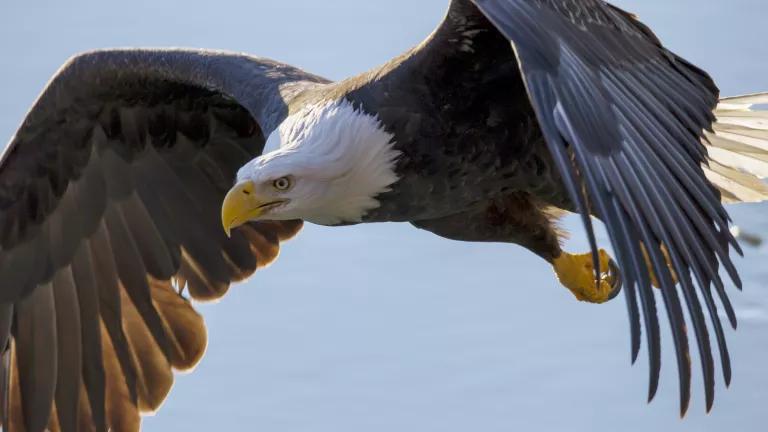10 Things You Didn't Know About the Endangered Species Act
We’ve all heard about it, but few of us really understand why this piece of legislation from the 1970s is so important—and in need of protection itself.

1. The law was inspired, in large part, by the bald eagle.
In 1966, concern for our national bird—which had drastically decreased in population due to hunting, habitat loss, and the rampant use of the toxic pesticide DDT—motivated Congress to pass the Endangered Species Preservation Act. It stated that the U.S. Departments of Interior, Agriculture, and Defense must protect listed species and their habitats. In 1973, after a series of amendments, this original framework expanded and evolved into the Endangered Species Act.
2. There’s a difference between “endangered” and “threatened.”
If a species is classified as “endangered,” it means it is in danger of becoming extinct throughout all or a significant portion of its range; it if is deemed “threatened,” it’s considered at risk of becoming endangered within the foreseeable future.
3. Plants outnumber animals.
At least when it comes to the number of endangered and threatened species in the United States. Most of those plants are flowering species, such as South Texas ambrosia and short-leaved rosemary.
4. Species are added to the list one of two ways.
Either biologists at the U.S. Fish and Wildlife Service add candidates based on the findings of their own assessments, or they respond to a public petition. Under the act, anyone can submit a written petition, and you must be notified within 90 days whether your request warrants further research (and that must be completed within a year). Thirty days after a listing is added, it becomes effective.
5. It works.
The act doesn’t just stop the bleeding; it requires the federal government to prepare a recovery plan so that the listed species can be restored to a healthy population—and eventually come off the list. A whopping 99 percent of the species granted protection under the act have managed to survive until today, and a growing number—including the bald eagle, American peregrine falcon, Eggert’s sunflower, and red kangaroo—have recovered enough to be delisted, meaning they're no longer in danger.
6. Saving one species can save countless others.
Because each plant or animal is part of a larger ecosystem, preserving any one could create a ripple effect. The gray wolf is a great case study. When the species was reintroduced to Yellowstone National Park—more than 20 years after being listed as endangered in 1974—the impact was far-reaching. The packs helped keep the elk population in check, which meant that willow and aspen trees were in less danger of being overeaten. The branches and leaves of those trees cooled the streams, which boosted the population of native trout, provided homes for migratory birds, and supplied more food for beavers. The dams built by the beavers created happier marshland habitat for otters, mink, and ducks. And the benefits go on and on.
7. Climate change is making the act even more important.
In 2008, the polar bear became the first species given protection under the Endangered Species Act due to the threat of global warming (melting sea ice, in this instance). In 2011, the whitebark pine became the first widely dispersed tree species to be designated as a candidate for endangered species protection, as it was threatened by pine beetles spreading to higher elevations due to warmer temperatures.
8. Congress consistently tries to weaken it.
Bills are regularly introduced to undermine the act. See the “Endangered Species Management Self-Determination Act,” “Common Sense in Species Protection Act of 2015,” and the “21st Century Endangered Species Transparency Act.” Much of this proposed legislation places short-term economic gain above long-term conservation efforts and demands changes (requiring state consent, for example) that would make it much more difficult to protect species. And sometimes other less-obvious bills—relating to the federal budget, defense, or food or water security—can have provisions that chip away at protections for specific species.
9. So do businesses.
Take the case of the coastal California gnatcatcher, a small gray bird in Southern California. Real-estate developers and toll road agencies have fought federal protection for this particular species, which picked a piece of pretty pricey land on which to built its nests. Some corporations have even filed a petition claiming the bird isn’t a valid subspecies to try to delist it.
10. You can help enforce it.
Write your lawmakers and tell them to vote against the most recent proposals that would gut the act. The law also includes a citizen suit provision, which means any person or organization can file a lawsuit to stop any party, including a governmental agency, that is in violation of the act.
This NRDC.org story is available for online republication by news media outlets or nonprofits under these conditions: The writer(s) must be credited with a byline; you must note prominently that the story was originally published by NRDC.org and link to the original; the story cannot be edited (beyond simple things such as grammar); you can’t resell the story in any form or grant republishing rights to other outlets; you can’t republish our material wholesale or automatically—you need to select stories individually; you can’t republish the photos or graphics on our site without specific permission; you should drop us a note to let us know when you’ve used one of our stories.

Protecting Biodiversity Means Saving the Bogs (and Peatlands, Swamps, Marshes, Fens…)
How to Become a Community Scientist
These 5 Animals Would Be Goners Without the Endangered Species Act